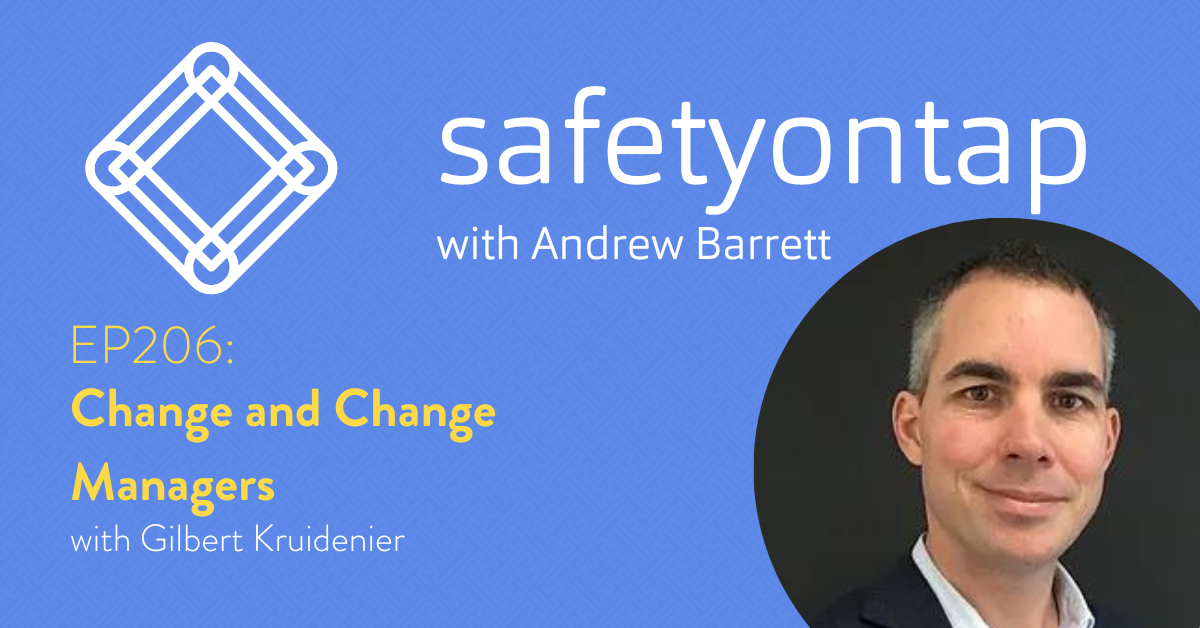Change! It’s the only thing that stays the same in health and safety. Today’s guest is a professional change manager, though the label doesn’t entirely capture what he does and how he does it.
Hey, it’s Andrew, and this is Safety on Tap.
Since you’re listening in, you must be a leader wanting to grow yourself and drastically improve health and safety along the way. Welcome to you, you’re in the right place. If this is your first time listening in, thanks for joining us and well done for trying something different to improve! And of course welcome back to all of you wonderful regular listeners.
Gilbert Kruidenier is my guest today. He has worked all over the world in operations, process improvement, and change, which seems to be where he adds the most value, because that’s why his phone keeps ringing. In some ways, for many of you, he is also a window into the future, designing his work around projects rather than permanent roles. He is a university lecturer on change, a leader in the Change Management Institute here in Australia, and co-author of the book ‘Bad Change: 50 ways change doesn’t work and 266 tips to make things better!’
This conversation is a little longer than my usual interviews. I’m sorry if that doesn’t fit into your commute or gym session, but I’m not sorry ‘cos of how interesting and useful this conversation was, and we barely scratched the surface.
Here’s Gilbert:
What did you take away from the conversation?
Here’s my three takeaways from that chat with Gilbert Kruidenier:
Takeaway #1: You need to think about change, and do it deliberately. At the same time, you need to think critically about any change model you want to use, because they are all wrong. Figuring out the bits that will help you is work, and that’s exactly what we are paid to do.
Takeaway #2: What resourcing do you put in place for change? Gilbert is a Change Manager, and we talked about the interaction between change managers, project managers, business analyst on the change team. They have different roles. For large organisations and big projects, are you engaging specialist help? For the rest of the time, how are you defining roles for the people you already have? Who is managing the schedule? Who is engaging the stakeholders? Who is working on comms? The budget? Consultation? Documentation? The list goes on. Who does what is important, whether you use the people you’ve already got or have specialists perform these roles.
Takeaway #3: This is probably the single juiciest insight, and it’s the shortest. Do change with people, not to people. Easy to say, slow, messy, and sometimes painful to do, but it is ultimately what will deliver real and sustained change. As Gilbert said, nothing about me without me.
I forgot to mention Gilbert’s book, with co-author Peter Phan, is more cartoon than business book, it’s called ‘Bad Change’ and I’ve linked to it in the show notes, all profits from the book go to the National Homeless Collective. So the link to the book, along with a transcript of this episode if reading is more your thing, is at safetyontap.com/ep206.
Thanks so much for listening. Until next time, what’s the one thing you’ll do to take positive, effective or rewarding action, to grow yourself, and drastically improve health and safety along the way?
Seeya!
Transcript – Ep206: Change and Change Managers, with Gilbert Kruidenier
Feel free to share this with your team/colleagues!
Feel free to share this with your team/colleagues!

Great podcast
Thanks for your feedback Chin!